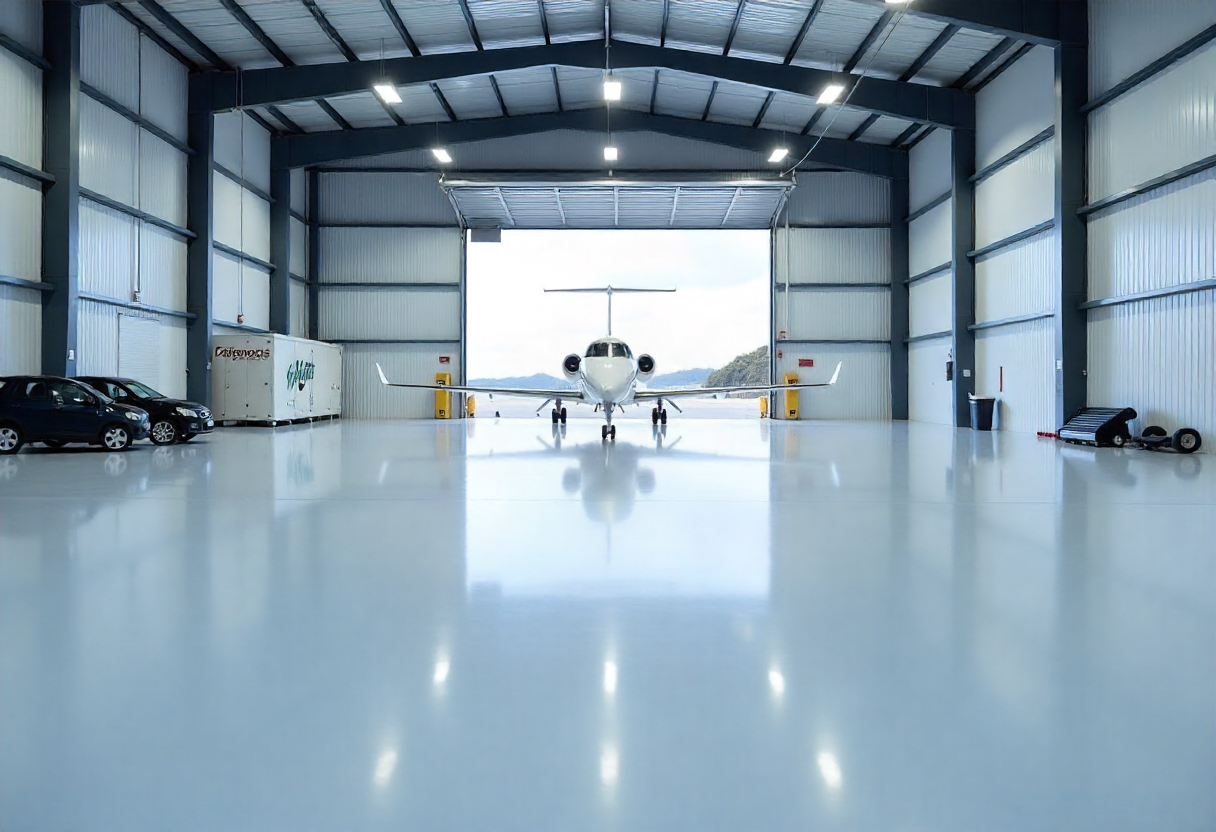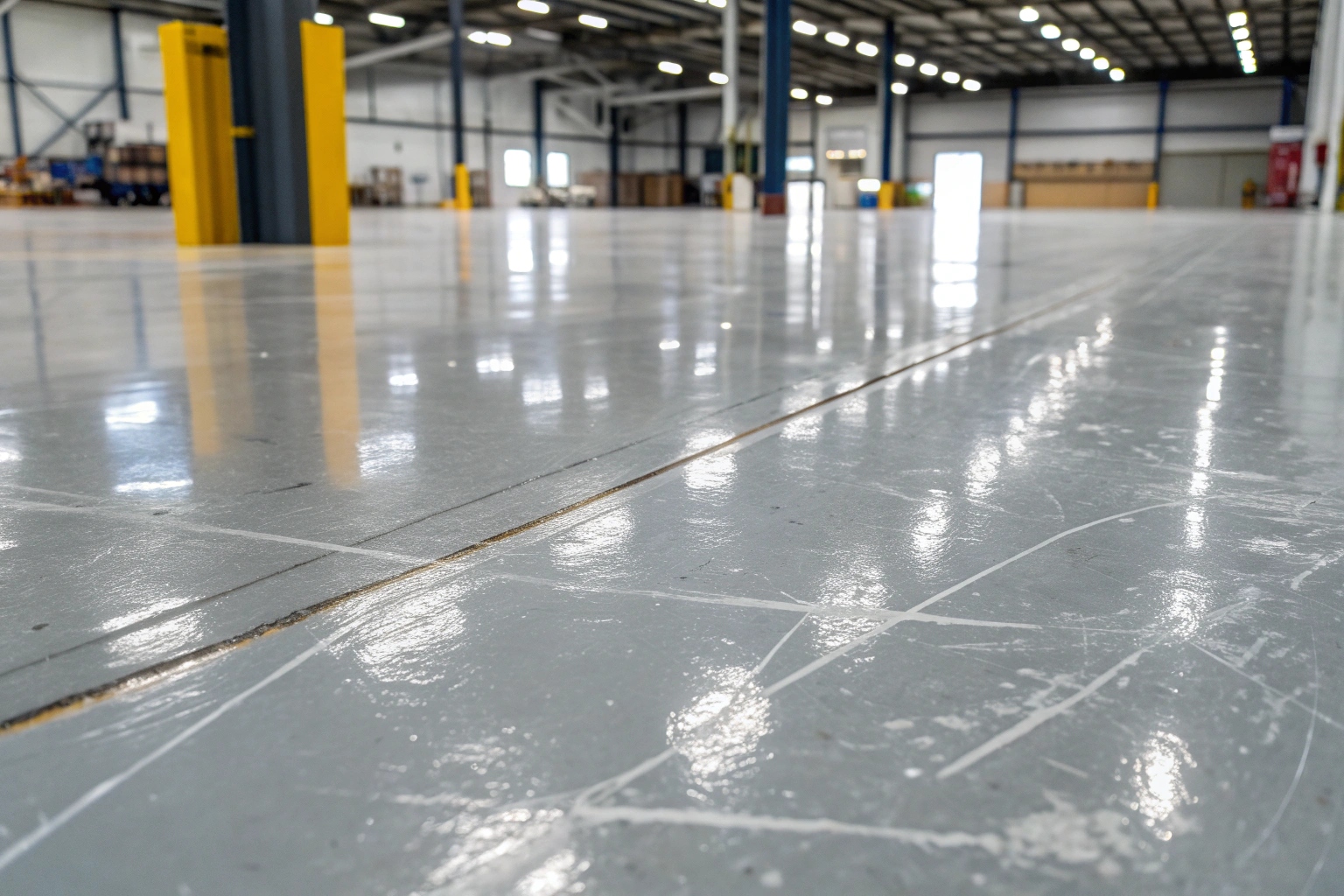What makes aircraft hangar epoxy flooring different in Wollongong:

- Complete fuel resistance – Protection against both aviation gasoline and Jet A-1 fuel exposure that would destroy standard coatings
- Static dissipative properties – Controlled electrical resistance preventing static buildup around sensitive aircraft systems
- Extreme load bearing – Supporting aircraft weighing tons plus ground equipment without cracking or delaminating
- Chemical immunity – Resistance to hydraulic fluids, de-icing chemicals, oils, and maintenance solvents
- FOD prevention – Surfaces that don’t chip, flake, or generate foreign object debris that could damage aircraft engines
- Easy decontamination – Quick cleanup protocols for fuel spills and maintenance activities that keep operations running
- Regulatory compliance – Meeting CASA requirements, airport standards, and insurance specifications for aviation facilities

Specialized Flooring Requirements for Different Aircraft Hangar Zones
Installing Aircraft Hangar Epoxy Flooring Without Disrupting Operations
Upgrading aircraft hangar floors isn’t just about durability — it’s about keeping operations running smoothly. With the right planning and precision, epoxy flooring can be installed without grounding aircraft or halting maintenance.
- Smart Planning & Phased Work: Projects are carefully scheduled around flight operations. Large hangars are divided into sections, allowing one area to cure while others stay in use. Every plan is tailored to minimize downtime.
- Security & Compliance: All work follows strict aviation security protocols, including clearance checks, FOD prevention, and equipment control to maintain safety and compliance.
- Surface Preparation & Quality: Unlike standard floors, hangar epoxy systems demand advanced surface prep — diamond grinding, moisture testing, and corrosion treatment — to ensure long-lasting performance even in coastal climates.
- Controlled Conditions: Proper ventilation, temperature, and humidity are maintained during installation to achieve perfect curing and prevent contamination.
- Fast Turnaround: Depending on the coating type, floors can be walk-ready in 24–48 hours and fully load-ready within a week. Polyaspartic systems can cut downtime even further.

Why Marble Effect Epoxy Outperforms Real Marble Every Single Time
Aircraft hangar epoxy flooring is a long-term investment that typically costs between $80–$150 per m², or up to $200+ for high-performance systems. For most private hangars in Wollongong, this equates to around $50,000–$75,000. While the upfront cost is significant, proper aviation-grade flooring saves money over time by preventing contamination, static discharge damage, and frequent repairs. It also reduces downtime, lowers maintenance costs, and can even decrease insurance premiums. With a lifespan of 15–20 years, epoxy flooring offers better performance and lower total ownership costs than cheaper alternatives. Beyond protection, it adds property value, enhances safety, and improves operational efficiency—making it a smart long-term business investment rather than just an expense.

Your Aircraft Hangar Deserves Aviation-Grade Flooring
Wollongong’s aviation facilities face unique challenges—from coastal salt air to strict regulations and heavy aircraft loads. Aviation-grade epoxy flooring isn’t just about looks; it safeguards your aircraft, ensures safety and compliance, prevents contamination, and maintains a professional image.
Whether at Wollongong Airport or private hangars across the Illawarra, investing in high-performance epoxy flooring reduces maintenance costs, eliminates environmental risks, and supports seamless operations. Don’t wait for floor failure—choose aviation-grade systems designed for Wollongong’s conditions and installed by experts who understand aviation standards.
Because your aircraft deserve more than a floor—they deserve a foundation built for performance, protection, and long-term reliability.
Why Wollongong's Aviation Facilities Need Specialized Local Expertise
Coastal Environment Challenges
Wollongong’s coastal setting exposes aviation floors to constant salt air and chloride contamination, which can cause blistering and delamination if not properly managed. Salt attracts moisture, creating pressure beneath coatings that leads to failure. Local experts understand this and use specialized surface cleaning and primers designed to resist salt-induced damage.
Temperature and Humidity Fluctuations
The region’s daily shifts in temperature and humidity cause concrete and epoxy to expand and contract. Local contractors use flexible, aviation-grade resin systems and monitor dew points during installation to prevent curing issues and ensure long-term adhesion.
Local Aviation Industry Knowledge
Wollongong’s aviation sector includes private hangars, flight schools, maintenance facilities, and helicopter operations—all with unique flooring demands. Local specialists design flooring systems suited to these varied needs, rather than relying on generic commercial coatings.
Regulatory and Environmental Compliance
Aviation projects in the Illawarra region must meet strict airport security, environmental, and groundwater protection standards. Contractors familiar with Wollongong’s regulatory environment ensure installations meet CASA, SafeWork NSW, and local environmental requirements.
Concrete and Substrate Conditions
Local concrete behaves differently due to salt exposure and moisture cycling. Contractors with experience in Wollongong know how to assess and treat these substrates for proper adhesion and durability.
Local Support and Accountability
Working with local contractors ensures fast response times, reliable material access, and long-term support—critical for aviation facilities where downtime is costly. Their reputation depends on performance, making accountability and quality assurance part of every project.
Getting Started with Your Aircraft Hangar Flooring Project
Once you decide that aircraft hangar epoxy flooring is the right choice for your Wollongong facility, the process begins with an on-site consultation and facility assessment. We evaluate your current floor, understand your operational needs, and identify any constraints or special requirements. Next, we conduct testing—checking for moisture, concrete strength, contamination, and surface condition—to ensure the substrate is ready for coating. Based on our findings, we design a tailored flooring system that meets your load, chemical, and compliance needs, complete with detailed proposals and warranties. After approval, we plan logistics around your operations to minimize disruption, coordinating aircraft movement, materials, and installation timing. Throughout the installation, we maintain clear communication, document progress, and verify quality. Once complete, we provide maintenance guidelines, test results, and long-term support—ensuring your hangar floor continues performing at aviation standards for years to come.
FAQs About Aircraft Hangar Epoxy Flooring
What do I need to know about epoxy flooring before installing it in my Wollongong hangar?
Aircraft hangar epoxy flooring isn’t like the DIY kits you see at Bunnings—it’s a specialized system that needs to handle jet fuel, support aircraft loads, and dissipate static electricity. In Wollongong’s coastal environment, you need aviation-grade products with primers that resist salt-induced blistering, which standard epoxies can’t handle. The installation requires proper documentation for insurance and CASA compliance, so make sure your contractor provides complete records. Budget 5-7 days for full cure before parking aircraft, and expect to invest $80-150 per square meter for proper aviation-grade systems.
The other thing people mention is the initial smell during installation. The epoxy has a chemical odor while it’s curing, though it dissipates completely once it’s done. For residential clients, we usually recommend planning the installation when you can open windows or maybe spend a day or two elsewhere if you’re sensitive to smells.
What should you not put on an epoxy floor in an aircraft hangar?
Don’t use acidic cleaners (vinegar-based products) or highly alkaline degreasers above pH 10—they’ll break down your topcoat over time even on aviation-grade systems. Avoid metal jacks or equipment with sharp edges that concentrate weight on tiny contact points, as they can chip even the toughest epoxy. For Wollongong facilities dealing with salt buildup, skip the harsh cleaners—neutral pH products work fine without damaging your floor. Also never use steel wool or abrasive scrubbing pads, as they’ll scratch the surface and create spots where contaminants can penetrate.
How many coats of epoxy flooring are needed for aircraft hangars?
Aviation-grade hangar floors typically need 3-5 coats: a penetrating primer, one or two base coats (often with static dissipative materials), and 1-2 topcoats for chemical resistance and wear protection. The exact number depends on your substrate condition and what chemicals you’re dealing with—maintenance bays with heavy Skydrol exposure might need additional base coats. For Wollongong’s coastal hangars, we often add an extra moisture-blocking primer coat because of salt contamination in the concrete. The total system thickness usually runs 10-20 mils (about 0.25-0.5mm), which is much thicker than standard commercial epoxy systems.
What tools are needed for epoxy flooring installation?
Professional aviation floor installation requires diamond grinders or scarifiers for surface prep, industrial dust extraction systems (critical at Wollongong Airport for FOD control), moisture meters and calcium chloride test kits, mil thickness gauges, and surface resistance meters for static testing. You’ll also need specialized application tools: notched squeegees for spreading epoxy, spike rollers for releasing air bubbles, and spiked shoes for walking on wet coatings. The environmental control equipment matters too—we bring dehumidifiers, fans, and sometimes heaters to manage Wollongong’s coastal humidity during installation. This isn’t DIY territory—the equipment investment alone runs $50,000-100,000+ for professional-grade tools.
What surfaces can epoxy be applied to in aircraft hangars?
Aviation epoxy works best on properly prepared concrete substrates—that’s what 95% of hangar floors are anyway. The concrete needs to be structurally sound (minimum 25 MPa strength), properly cured (at least 28 days old), and free from contamination like fuel, oil, or salt. We can’t apply epoxy over existing coatings, vinyl tiles, or painted concrete—those all need complete removal first. In older Wollongong hangars with deteriorated concrete, we sometimes need to do substrate repairs or even pour new concrete sections before epoxy installation makes sense. If your hangar has steel plate floors or other non-concrete surfaces, epoxy isn’t the right solution—you’d need different coating systems entirely.

